
views
Contacting Your Ex-Spouse

Find out why payment has stopped. If your ex-spouse has stopped making payments, try to find out why. Your ex-spouse may have lost his or her job, or been injured gotten too sick to work, or incurred significant medical expense. If you know why the payments have stopped, you will know whether you can expect your ex to voluntarily resume payment as soon as he or she is able.

Determine whether your ex-spouse is employed. If your ex has a job, then he or she should probably be able to keep making alimony payments. As long as he or she is not self-employed, you can try to get an earnings assignment (also called wage garnishment) from the employer. Look on websites such as LinkedIn or Facebook to see if your ex-spouse lists a particular occupation or employer. You may also want to conduct a simple internet search of his or her name. You may find your ex's name on an employer's website.

Try to reach an agreement. In some cases, an ex-spouse may temporarily stop making payments due to uncontrollable circumstances, such as losing a job or a medical emergency. You can choose to negotiate an agreement with your ex to reduce or suspend the alimony payments until a future date. You don't have to go to court to make a new agreement, but make sure your ex-spouse understands that you are willing to go to court if he or she does not start making payments again. If you do make a new agreement, make it in writing and signed by both parties. Consider hiring an attorney to draft the agreement for you. If you do not come to an agreement, your ex-spouse is still responsible to pay the full amount of support unless she or he seeks temporary relief from the court.

Proceed even if you cannot make contact. If your ex-spouse has disappeared, you can still file an action with the court. The court may permit you to give "notice by publication" of the action if you can demonstrate that you have tried and failed to locate your ex-spouse. Then you can publish notice of the action in a local newspaper and ask the court for a default judgment in your favor. Collecting on your default judgment will still be difficult, but if you can locate property belonging to your ex, the court may order that a lien or levy be placed on the property. To locate your ex-spouse, try: Searching the phone book where he or she lives or used to live; Asking your ex's friends, relatives, landlords, and former employers; Asking the local post office if your ex left a forwarding address; Checking the records of your tax collector or property assessor to locate any property your ex owns locally; Contacting the Department of Motor Vehicles and ask about vehicles registered in your ex's name; Checking the registrar of voters; and Hiring a private investigator.
Requesting an Earnings Assignment
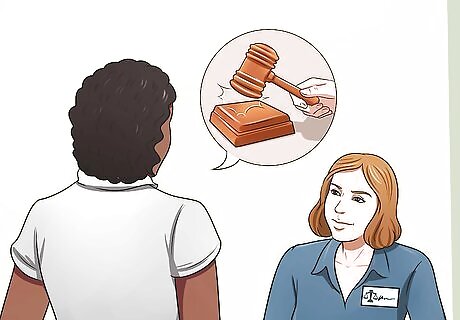
Determine whether the court already ordered an earnings assignment. Earnings assignments (also known as wage garnishments) are a common way to collect debts. In some states, courts will order an earnings assignment along with the alimony order, but will suspend the earnings assignment as long as the ex-spouse continues to make alimony payments. If your ex-spouse stops making payments, you can ask the court to reinstate the earnings assignment order. Otherwise, you will need to request an earnings assignment. If the judge already made an earnings assignment order that has been suspended, you may only need to file a Request For Order (like this one: http://www.courts.ca.gov/documents/fl300.pdf) asking that the order be reinstated.
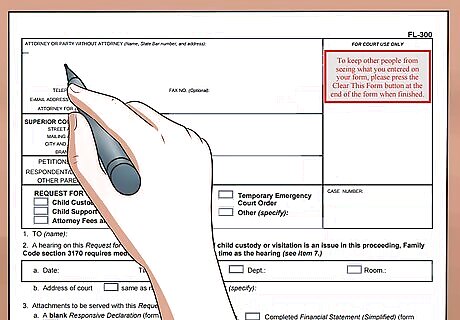
Complete the proper forms. If the court did not issue a suspended earnings assignment order before, you can request an earnings assignment by filing a few forms and attending a hearing. Different courts use different forms for requesting earnings assignments. Ask your court clerk for the forms you need to make your request. Expect to file an application for an earnings assignment (like this one: http://www.courts.ca.gov/documents/fl430.pdf) and a blank proposed order for the judge to complete and sign (like this one: http://www.courts.ca.gov/documents/fl435.pdf).

File and serve your paperwork. To file your paperwork, take it to the court clerk, who will assist you with filing. You may be required to pay a filing fee. If you cannot afford the fee, ask for information on how to file an application for a fee waiver. You will need to have copies of the documents served upon the other party by having someone over the age of 18 and not involved in the case give the documents to him or her.
Enforcing an Alimony Order in Other Ways
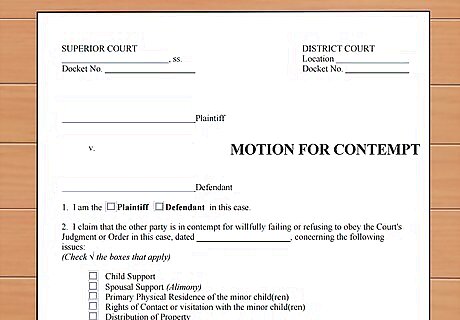
File a contempt motion or motion to enforce the support order. If your ex-spouse refuses to pay court-ordered spousal support, then you may be able to seek a contempt or enforcement order, depending upon your state. These motions ask the court to enforce the support order by punishing the ex-spouse for failing to pay or by awarding you property or other assets to satisfy the debt. Ask the court clerk for the appropriate forms, which should include a “Contempt Motion” or “Contempt for Disobedience of an Order for Alimony" form available. Be prepared to list the dates of missed payments and their amounts. The court may impose fines or jail time upon your ex-spouse to compel him or her to continue making payments. If your ex-spouse fails to make alimony payments, you can request permission from the court to take some assets as payment, or force your ex-spouse to sell some property and pay you with the proceeds. The court might also issue a “Qualified Domestic Relations Order” (QDRO). Such an order might entitle you to receive unpaid alimony out of your ex-spouse’s retirement plans, such as 401Ks, 403Bs, and other ERISA plans (but not IRAs).

Ask for arrears. Asking for arrears means requesting that the court calculate how much money in back payments your ex-spouse owes you and order that he or she pay you that amount. Ask the court clerk for the proper forms to request that the court calculate and order payment of the arrears. These forms should include a Request For Order, an Application to Determine Arrearages, and a Declaration of Payment History. The court may order that your ex-spouse make an additional payment each month to catch up with the unpaid arrears. In addition, each missed payment is subject to annual interest, which can grow substantially. For example, in California, the legal interest rate is 10% annually.

Contact your local child support agency if child support is involved. If your ex-spouse owes child support in addition to alimony, contact your local child support agency. The agency will work on your behalf to enforce the support orders in court. However, if there is no child support order, the agency will not get involved in your case. The agency can help you put pressure on your ex-spouse by asking the court to: Suspend a driver's license; Suspend a passport; Levy a bank account; Intercept a tax refund or lottery winnings; or even Issue a "seek work order," ordering your ex to look for work.
Going to Court

Get a hearing date from the clerk. After you file your documents, the court clerk will give you a hearing date. You may receive your hearing date at the time you file, or later by mail after the court has processed your filing. Depending on how impacted your court system is, your hearing may occur within weeks or months.
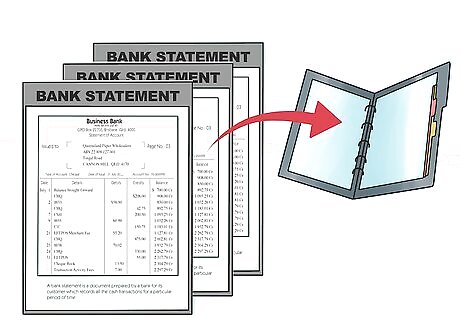
Assemble your evidence. Calculate and document the amount of support your ex-spouse has failed to pay, including the dates when those payments were due. Print out bank statements to show that no alimony has been deposited into the account. Also bring copies of any letters or other forms of communication you have had with your ex or your ex-spouse’s attorney. Make copies of your evidence for the judge and for your ex-spouse, and assemble them in binders for easy reference. Summarize your evidence in a spreadsheet, showing how you calculated how much money went unpaid during each pay period, how you calculated the interest, and the total amount your ex spouse still owes.
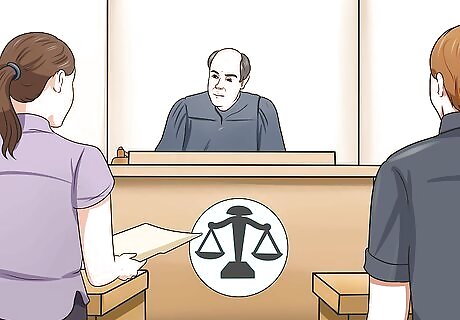
Attend the hearing. If you are representing yourself without an attorney, explain to the judge that you have not received payment and be prepared to show the judge the evidence yyou prepared. Because you are the party requesting an order from the court, you will present your case first. Your ex-spouse will have a chance to respond. Your ex-spouse (or his or her attorney) may question you as a witness. If you are called as a witness, answer questions directly and respectfully.

Follow through. What happens next depends upon what type of relief you requested and what type of relief the court orders. For example, if the court makes an earnings assignment order, you will need to serve the order upon your ex-spouse and upon his or her employer. If the court authorizes a lien on your ex's property, you will need to file your lien with the county recorder's office. In most circumstances, the court will not collect the debt for you, so you must be vigilant about enforcing your rights.


















Comments
0 comment